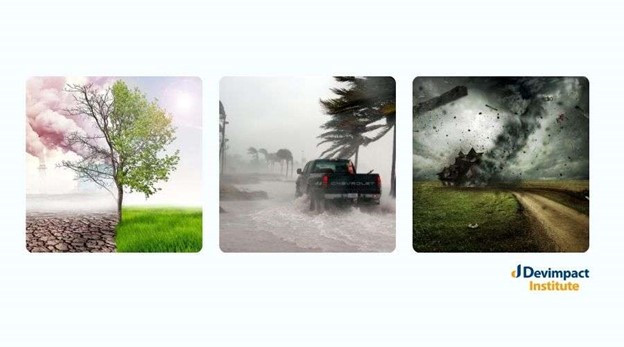Training on Climate Change and Disaster Management
About the Course
For more than a decade, development and humanitarian practitioners have been advocating for an approach that integrates disaster risk reduction and climate change adaptation to build resilience in a sustainable way. Disasters and climate change both have similar consequences for people’s lives. There is significant overlap between the problems that disaster risk reduction and climate change adaptation seek to address.
Disaster risk reduction covers non-climate related disasters such as earthquakes. But it also addresses climate-related disasters such as floods, droughts, cyclones and storm surges. With climate change predicted to increase the frequency and/or intensity of climate-related hazards and effects, populations already exposed to those hazards and effects will be at greater risk.
This training on climate change and disaster management is designed to address critical global challenges, equip participants with essential knowledge and skills, and promote sustainable, resilient, and equitable practices. The comprehensive and practical nature of the training ensures that participants are well-prepared to make meaningful contributions in their professional and personal capacities.
Target Participants
The target participants for this training on climate change and disaster management include professionals and practitioners from various sectors, including government agencies, non-governmental organizations (NGOs), international organizations, and private companies involved in environmental management, urban planning, public health, and emergency response. It is also aimed at policymakers, researchers, educators, and community leaders who play a crucial role in developing and implementing strategies to combat climate change and manage disasters.
What You Will Learn
By the end of this course the participants will be able to:
- Understand sustainable practices for climate change mitigation, such as renewable energy solutions, energy efficiency, and carbon sequestration techniques
- Discuss key factors associated with climate science
- Describe relevant implementation and operational activities for climate change
- Explain communication methods with stakeholders about your climate activities
- Enhance participants’ knowledge of international frameworks and agreements related to climate change and disaster management
- Discuss practical climate change and disaster risk reduction measures for relevant sectors, including health, agriculture and livelihoods
- Highlight best practices and case studies that illustrate successful resilience-building initiatives
Course Duration
Classroom Based – 5 Days
Online – 7 Days
Course Outline
Understanding Climate Change
- Definition and concepts
- Causes of Climate Change
- Historical climate change vs. contemporary climate change
- The greenhouse effect and global warming
Impacts of Climate Change
- Environmental impacts (rising sea levels, extreme weather events)
- Economic impacts (agriculture, infrastructure damage)
- Social impacts (health, migration)
Climate Change Policy and Agreements
- International frameworks (Kyoto Protocol, Paris Agreement)
- National and local policies
- Role of non-governmental organizations
Basics of Disaster Management
- Definitions and concepts
- Types of disasters (natural and man-made)
- Phases of disaster management (prevention, preparedness, response, recovery)
Risk Assessment and Vulnerability Analysis
- Hazard identification
- Risk assessment methodologies
- Vulnerability and capacity assessment
Disaster Management Cycle
- Mitigation strategies
- Preparedness planning
- Emergency response
- Recovery and reconstruction
Intersection of Climate Change and Disasters
- Climate-Induced Disasters
- Case studies of recent climate-related disasters
- Impact of Climate Change on Disaster Frequency and Intensity
- Community-based adaptation strategies
- Ecosystem-based approaches
- Infrastructure resilience
Principles of Disaster Risk Reduction
- UNDRR Sendai Framework
- Key DRR concepts and approaches
Early Warning Systems
- Components of effective early warning systems
- Technological tools and innovations
- Community-Based Disaster Risk Management (CBDRM)
Role of Technology and Innovation in Disaster Management
- Use of GIS and remote sensing
- Data analytics and AI in disaster management
Climate Change Adaptation Strategies
- Adaptation planning and policies
- Sector-specific adaptation (agriculture, water resources, health)
Mitigation Strategies to Combat Climate Change
- Renewable energy solutions
- Energy efficiency and conservation
- Carbon sequestration techniques
- Integrating Adaptation and Mitigation in Disaster Management
Policy, Governance, and Ethical Considerations
- International and National Policy Frameworks
- Role of governments and international organizations
- Climate justice and vulnerable populations
- Ethical considerations in disaster response
Training Approach
This course is delivered by our seasoned trainers who have vast experience as expert professionals in their respective fields of practice. The course is taught through a mix of practical activities, presentations, group works and case studies.
Training notes and additional reference materials are provided to the participants.
Certification
Upon successful completion of this course, participants will be issued a certificate accredited by the ISANRRC.
Tailor-Made Course
We can also do this as a tailor-made course to meet organization-wide needs.
Training Approach
This course is delivered by our seasoned trainers who have vast experience as expert professionals in their respective fields of practice. The course is taught through a mix of practical activities, theory, group works and case studies.
Training manuals and additional reference materials are provided to the participants.
Certification
Upon successful completion of this course, participants will be issued a certificate.
Tailor-Made Course
We can also do this as a tailor-made course to meet organization-wide training needs. A training needs assessment will be done on the training participants to collect data on the existing skills, knowledge gaps, training expectations and tailor-made needs.
